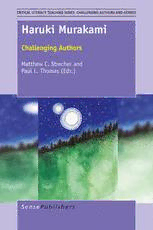
Haruki Murakami: Challenging Authors PDF
Preview Haruki Murakami: Challenging Authors
Haruki Murakami CRITICAL LITERACY TEACHING SERIES: CHALLENGING AUTHORS AND GENRES Volume 7 Series Editor: P. L. Thomas, Furman University, Greenville, USA Editorial Board: Leila Christenbury, Virginia Commonwealth University Sean P. Connors, University of Arkansas Jeanne Gerlach, University of Texas-Arlington Renita Schmidt, Furman University Karen Stein, University of Rhode Island Shirley Steinberg, University of Calgary; Director of Institute of Youth and Community Studies, University of the West of Scotland This series explores in separate volumes major authors and genres through a c ritical literacy lens that seeks to offer students opportunities as readers and writers to embrace and act upon their own empowerment. Each volume will challenge authors (along with examining authors that are themselves challenging) and genres as well as challenging norms and assumptions associated with those authors’ works and genres themselves. Further, each volume will confront teachers, students, and scholars by exploring all texts as politically charged mediums of communication. The work of critical educators and scholars will guide each volume, including concerns about silenced voices and texts, marginalized people and perspectives, and normalized ways of being and teaching that ultimately dehumanize students and educators. Haruki Murakami Challenging Authors Edited by Matthew C. Strecher Sophia University, Tokyo, Japan and Paul L. Thomas Furman University, USA A C.I.P. record for this book is available from the Library of Congress. ISBN: 978-94-6300-460-2 (paperback) ISBN: 978-94-6300-461-9 (hardback) ISBN: 978-94-6300-462-6 (e-book) Published by: Sense Publishers, P.O. Box 21858, 3001 AW Rotterdam, The Netherlands https://www.sensepublishers.com/ All chapters in this book have undergone peer review. Cover image by Ellie Warner Printed on acid-free paper All Rights Reserved © 2016 Sense Publishers No part of this work may be reproduced, stored in a retrieval system, or transmitted in any form or by any means, electronic, mechanical, photocopying, microfilming, recording or otherwise, without written permission from the Publisher, with the exception of any material supplied specifically for the purpose of being entered and executed on a computer system, for exclusive use by the purchaser of the work. TABLE OF CONTENTS Acknowledgements vii Introduction: Challenging Murakami ix Paul L. Thomas 1. The Haruki Phenomenon and Everyday Cosmopolitanism: Belonging as a “Citizen of the World” 1 Tomoki Wakatsuki 2. Our Old Haruki Murakami and the Experience of Teaching His Works in Japan 17 Yuji Katō 3. Haruki Murakami and the Chamber of Secrets 31 Matthew C. Strecher 4. Magical Murakami Nightmares: Investigating Genre through The Strange Library 47 Paul L. Thomas 5. Critical Engagement through Fantasy in Hard-Boiled Wonderland and the End of the World 59 Rebecca Suter 6. What’s Wrong with These People? The Anatomy of Dependence in Norwegian Wood 73 Jonathan Dil 7. The Transcreation of Tokyo: The Universality of Murakami’s Urban Landscape 87 Deirdre Flynn 8. “You’re Probably Not That Innocent Either, Mr. Murakami”: Translation and Identity between Texts in Murakami Haruki’s “Nausea 1979” 101 Daisuke Kiriyama 9. Challenging the Ambiguity of the te i (ru) Form: Reading “Mirror” in a Japanese Language Class 117 Chikako Nihei v TABLE OF CONTENTS Epilogue: Haruki Murakami as Global Writer 131 Matthew C. Strecher Coda: Art in Conversation with Art: Another One of “Murakami’s Children” I 135 Paul L. Thomas Author Biographies 145 vi ACKNOWLEDGEMENTS The editors (Matthew C. Strecher and Paul L. Thomas) are deeply indebted to Sense Publishers for supporting this volume and the series. We are honored to offer the contributions of the chapter authors as this volume represents a wide range of scholarship grounded in our common appreciation for the art of Haruki Murakami. Further, we want to acknowledge and thank Ellie Warner for her original artwork gracing the cover. Diligent proofreading was also provided by Kristen Marakoff, senior English major at Furman University, future high school teacher, and recent addition to the legion of Murakami. vii PAUL L. THOMAS INTRODUCTION Challenging Murakami “My enemy,” explains Frog toward the end of “Super-Frog Saves Tokyo,” “among other things, the me inside me” (Murakami, 2002, p. 111). Readers new and experienced of Haruki Murakami certainly notice the story’s literary name- dropping—Nietzsche, Conrad, Hemingway—among the blurring of genre: maybe this is fantasy, maybe, magical realism? As is the main human in the tale, Katagiri, readers are likely amused, compelled, and often befuddled. Simply stated at the beginning of this volume dedicated to challenging genres and authors, this odd Murakami story captures perfectly why the Japanese author who garners both massive popularity and solid critical acclaim fits perfectly into a collection of essays offered to readers, students, and teachers; Murakami’s work is challenging, and his work deserves to be challenged. This series and volume are grounded in and informed by critical pedagogy and critical literacy—both of which see text as opportunities to investigate negotiations of power, both of which embrace the essential nature of literacy in human agency and liberation. Just as Murakami’s fiction often includes two realities, the editing of this volume comes from an educator who remains strongly connected to teaching English and writing (Thomas) and a noted Murakami scholar (Strecher)—two overlapping but different ways to engage Murakami. CHALLENGING MURAKAMI As the essays collected here examine, Murakami, born in 1949, represents challenges to genre conventions, literary traditions (both Japanese and Western), translation, and literary analysis. Readers of Murakami in English translation are reminded Murakami also came to his literary stature in a non-traditional way: an “epiphany” during a baseball game in 1978 (Murakami, 2015): I think Hiroshima’s starting pitcher that day was Yoshiro Sotokoba. Yakult countered with Takeshi Yasuda. In the bottom of the first inning, Hilton slammed Sotokoba’s first pitch into left field for a clean double. The satisfying crack when the bat met the ball resounded throughout Jingu Stadium. Scattered applause rose around me. In that instant, for no reason and on no grounds whatsoever, the thought suddenly struck me: I think I can write a novel. ix
